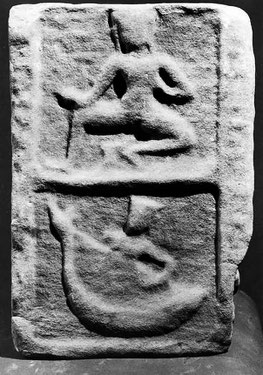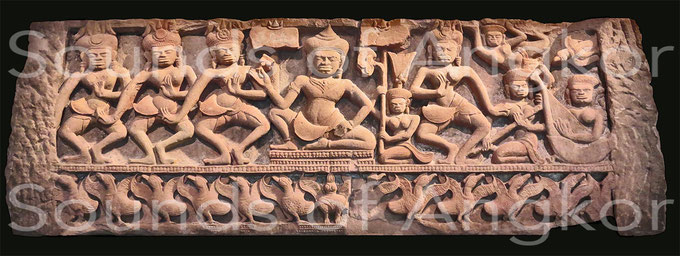Last update: December 5, 2023
A number of Angkorian arched harps are scattered around sites other than those dealt with specifically (Angkor Wat, Bayon, Banteay Chhmar, Terrace of the Elephants). We've grouped them together on this page. The sites covered are as follows: Ta Prohm, Preah Khan, Preah Pithu, Banteay Samre, Western Mebon, Angkor Thom West Gate, Ta Prohm Kel, Siamese lintel from the Asian Art Museum of San Francisco.
The harp of Ta Prohm
The Ta Prohm site has no musical iconography as such. A single bas-relief, badly damaged, once showed an orchestra reduced to its simplest expression: a harp, a zither and cymbals. Above this orchestra, sacred dancers.
The harp of Preah Khan of Angkor
This scene is the only musical performance at Angkor's Preah Khan. It could be a family offering ceremony. The sacred dancer in the center entertains the deity or deities the family honors. The musical ensemble consists of, from L. to R., an arched harp, a double-resonator stick zither, cymbals and a singer recognizable by his outstretched index finger. Late 12th - early 13th c.
The harp of Preah Pithu

The western lintel of Preah Pithu's U sanctuary depicts Shiva dancing on a Kâla head. He is surrounded by the other two Trimurti gods: Brahma and Vishnu. The dance is led by a harpist, below, to Shiva's left. This is an arched harp, a classic model from the Angkorian period. The string pattern is visible, but not the strings themselves. A foot, at the front of the instrument, is also discernible. Ganesha, the elephant-headed son of Shiva, faces the harpist. The position of his superimposed hands suggests that he plays cymbals, even though they are not depicted. Brahma and Vishnu also have superimposed hands, but cymbalettes are not represented either. In the ancient Khmer orchestra, there is always just one pair of cymbalettes, whose two clashing elements represent the sun and the moon. The two deities may simply be clapping their hands. In Sanskrit, the action of clapping is called tāla; it is undoubtedly a musical practice that existed in both India and the Khmer Empire.
On the far left, Kāraikkāl Ammaiyār holds a long object in his right hand, perhaps a rattle or sistrum (?)
The harps of Banteay Samre
The temple of Banteay Samre offers us an exceptional iconography for the representation of the Angkorian harp.
This high relief features a string orchestra and female dancers. The orchestra is made up of four female musicians playing two harps seen in perspective and a double-resonator zither. One musician, to the right and to the rear, is probably a second zitherist. The absence of cymbals is exceptional in this depiction. The woman with folded arms, seated in front of the harpists, is in a listening position. This position, between the musicians and the dancers, is usually dedicated to the first singer. But here, the imagery has none of the characteristics of this position, namely: outstretched hand or index finger, and sometimes open mouth. Its role therefore remains obscure.
Technologically speaking, both harps feature peg tuning and parallel strings. The sculptor took great care in their creation. However, the state of the sculpture makes it impossible to determine their number, especially as the number of strings and pegs seems inconsistent.
It is also worth noting that the zither player in the foreground wears a different hairstyle from the harpists and the musician behind her. Given that the zither is the melody-conducting instrument in the string orchestra, she could be in a dominant position in relation to the other musicians.
The harp of Prasat Chrung southwest of Angkor Thom
King Jayavarman VII built a temple at each of the four corners of Angkor Thom. Today, they're known as Prasat Chrung, and each is designated according to its orientation: northeast, northwest, southeast, southwest. They are architecturally identical, with only the decoration changing.
The south-west Prasat Chrung is decorated with four medallions depicting a string orchestra a minima and a dancer. The decoration is quite eroded, but the four figures are identifiable. This type of medallion has been known since the early Angkorian period. The most common show floral decorations, but sculptors were sometimes daring enough to create religious or everyday subjects.
Let's start with the medallion on the far right, the most significant. It appears to be a dancing jester, as seen elsewhere in Bayon, on the Terrace of the Elephants and at Banteay Chhmar. His left leg is mounted horizontally. All orchestras accompanying jesters are made up of musicians, not women. In this case, erosion does not allow us to determine gender, so we'll accept this hypothesis.
In the left medallion, a harp with a very arched neck.The strings are indicated by small horizontal lines running from the neck.The harpist's position is typical. Note that in jester dances, the harp is generally surmounted by a Garuda head, but we have already seen - Bayon, south outer gallery, east wing - that there are exceptions to this rule, which we ourselves have established in view of the numerous occurrences recorded in the Bayon period.
The second medallion from the left appears to depict a cymbal player.Only the position in which he is playing allows us to make this assumption, as the instrument is not visible.
The third medallion appears to show a single-stringed zither player; only the neck is visible, passing transversely in front of the figure's bust.
The harp of Western Mebon

This sandstone pilaster fragment deposited at the Angkor Conservation (Siem Reap - Ref. DCA. 1231-1 - N.566 - Dim. 29 x 21.5 x 20.5) comes from the Western Mebon (11th c.).
It shows a dancer and a harpist.The naviform instrument seems to end in a bird's head, like the Angkor Wat harp; this assertion, however, remains purely speculative.The resonance box has no foot.
The harp of Siam

This lintel from Siam (formerly Thailand) belongs to the Asian Art Museum of San Francisco.
To our knowledge, it is the only Khmer iconography from this country depicting a harp.
The central character likely embodies authority, possibly as a king or prince. On either side of this sovereign are two parasols and two fans. He is surrounded by four female dancers. Two female musicians make up the orchestra: the one on the left plays a single-string zither whose number of resonators cannot be estimated; however, at the time and in this context, it was normally two. The position of her right hand is characteristic of the playing technique of the ancient kinnara and the contemporary kse diev. The second hand plays the harp. The profile of the soundbox is reminiscent of the Western Mebon instrument above. The snake-shaped foot at the front of the soundbox is unusual, as is the top of the neck. At present, it is impossible to say with any certainty what it represents. The harpist's left hand rests on the strings, while her right hand holds the top of the neck.
This sculpture gives us an idea of the hierarchy of the whole if we read it from the central figure.The dancer to her left could be the dancing mistress. The position of the kinnara player, closest to the center, shows that this is the main instrument, driving the melody.The harp is relegated to the background. This iconography corroborates the hierarchy found in the Lolei list (9th c.).
Above the zither player is an apsara.





















